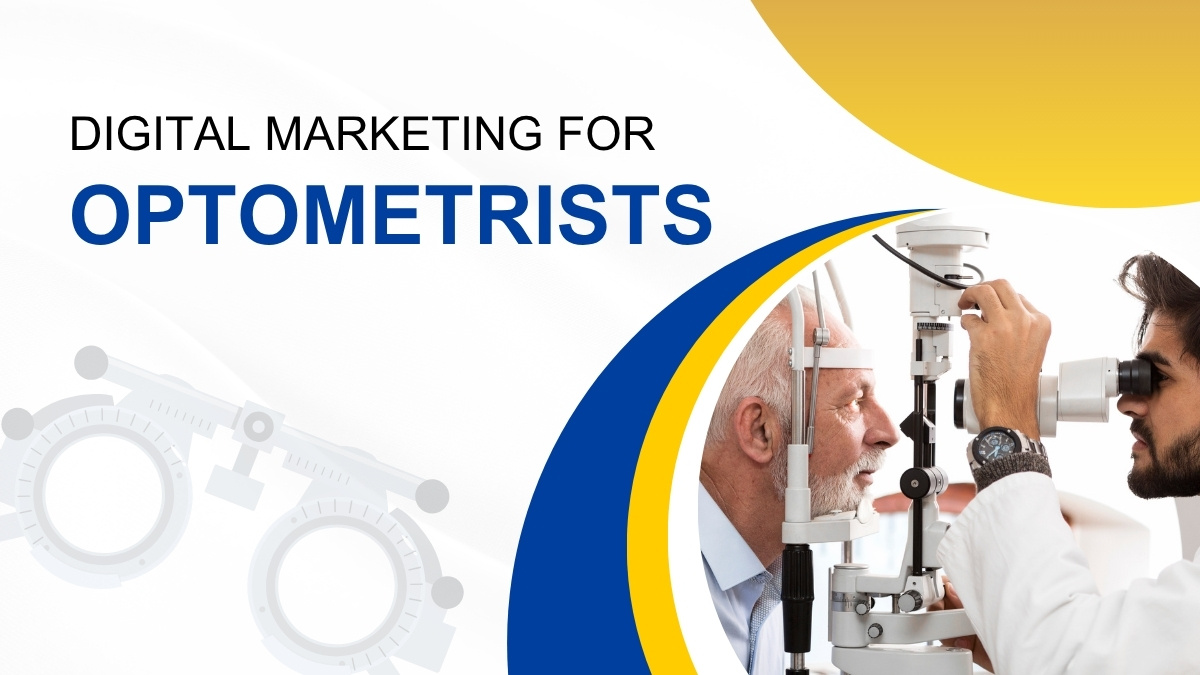
Digital Marketing for Optometrists
Your optometry practice is built on trust and expertise. Patients come to you for clear vision, but how do they find you in the first place? In the past, a good location and a listing in the phone book might have been enough. Today, your potential patients are online, searching for eye care professionals on their phones and computers. This is where digital marketing comes in, and it's your key to connecting with them.
Think of digital marketing as a modern-day map that guides patients directly to your door. It’s not about flashy tech or complicated jargon; it's about being present and helpful where your community is already looking.
This guide will walk you through everything you need to know, from the basics to specific strategies that will help your practice grow.
We'll cover the most effective tactics, how to get started, and common mistakes to avoid along the way.
Plus, we’ll dive deeper with practical examples, step-by-step instructions, and even case studies, so you’ll feel confident taking your first steps.
Why Digital Marketing Matters for Your Practice

Let's be direct: if your practice isn't visible online, you're missing out on new patients. When someone experiences blurry vision or needs a new pair of glasses, their first instinct is often to search "optometrist near me" on Google. If you don't show up in those results, for all practical purposes, you don't exist for that person.
Digital marketing is more than just being found; it's about building a modern practice that meets patient expectations.
-
A professional website and positive online reviews act as a digital handshake, showing patients that you are a trustworthy expert in your field before they even step into your office.
-
Unlike a billboard that everyone sees, digital marketing allows you to target specific demographics. You can reach families looking for pediatric eye care or older adults interested in managing age-related eye conditions.
-
You can track exactly how many people visit your website, call your office from an online ad, or book an appointment through your social media page. This data helps you understand what's working so you can invest your time and money wisely.
Case Study: Dr. Lee's Family Eyecare in Ohio doubled their new patient appointments in six months by launching a simple website, asking every patient to leave a Google review, and posting monthly eye health tips on Facebook. Patients said they chose Dr. Lee due to the informative posts and positive online reviews.
Essentially, investing in digital marketing is investing in the future and long-term health of your practice. It ensures a steady stream of new patients and solidifies your reputation as a leading eye care provider in your community.
Key Strategies to Help Your Practice Grow

Digital marketing isn't a single activity but a collection of tools. You don't need to master them all at once. Focusing on a few key strategies will make a significant impact.
1. Make Your Practice Easy to Find with Local SEO
Local Search Engine Optimization (SEO) is the process of making your practice more visible in local search results on Google, Bing, and even Apple Maps. It's the most crucial digital marketing strategy for any local business.
When someone searches for an optometrist, Google wants to show them the best, most relevant options nearby. Your goal is to convince Google that's you.
Actionable Steps:
-
Google Business Profile: This is your most important tool for local SEO, and it's completely free. Your Google Business Profile is the information box that appears on the right side of a Google search or on Google Maps.
-
Action: Visit Google Business Profile, claim your profile, fill out every detail, and keep your hours up to date.
-
Keywords on Your Website: Think about what terms people search for, like "eye exam [Your City]," "children's optometrist," or "contact lenses near me."
-
Action: Integrate these naturally into your webpage titles, headers, and descriptions. For example, on your services page: "We provide comprehensive eye exams in Tampa for families and individuals."
-
Online Directories: Make sure your practice information is consistent across directories like Yelp, Healthgrades, WebMD, and Vitals.
-
Action: Search for your practice online and update any outdated or incorrect info.
Advanced SEO Tips:
-
Create Location-Specific Pages: If you have more than one office, create a separate landing page for each location, optimized for "[Eye Doctor] in [City Name]."
-
Gather Backlinks: Ask local organizations you partner with (schools, community centers) to link to your website. Guest blog or share resources in exchange for a link back to your site.
Example: Dr. Patel created a FAQ page answering the 10 most common eye health questions patients asked. Not only did this increase her website’s search traffic, but it also built trust, since her answers appeared in Google’s featured snippets.
2. Build Community with Social Media
Social media is your digital waiting room—a place to connect with your community, share helpful information, and show the human side of your practice. You don't need to be on every platform. Choose one or two where your patients are most likely to be: Facebook and Instagram are especially effective for optometrists.
Actionable Steps:
-
Showcase Your Practice Culture: Post photos of your friendly staff, your modern office, or a happy patient picking up their new glasses (with their permission, of course).
-
Tip: Share short video testimonials from satisfied patients (again, ask for permission) or a “day in the life” with your staff.
-
Educate Your Audience: Post simple eye health tips, explain the importance of annual eye exams, or bust common myths about vision.
-
Example Post: “Did you know staring at screens for too long can cause digital eye strain? Blink often and take short breaks every 20 minutes!”
-
Promote Special Offers: Running a back-to-school special on kids' exams or a discount on a second pair of glasses? Social media is the perfect place to announce it.
-
Use Hashtags: Hashtags like #EyeCare, #HealthyVision, or #[YourCityEyeDoctor] help your posts reach local audiences.
Case Study: VisionNow, a two-location practice, grew their Facebook followers by 800% and increased appointment requests after sharing weekly "Eye Myth Monday" posts and running occasional contests for free sunglasses.
3. Stay in Touch with Email Marketing
Email marketing is a powerful way to keep your practice top-of-mind with existing patients. It’s a direct line of communication you own, unlike social media, which can change its rules at any time.
Actionable Steps:
-
Automated Appointment Reminders: Use simple software like Solutionreach, Mailchimp, or even your practice management system to automatically remind patients about upcoming visits.
-
Newsletters: Create a monthly or quarterly newsletter with tips, seasonal eye care advice, practice news, and staff spotlights.
-
Example: "This month’s tip: The best sunglasses to protect your eyes this summer."
-
Segment Your List: Send personalized offers to patients based on whether they wear glasses or contacts, or if they’re overdue for an exam.
Step-by-Step:
-
Collect emails during intake.
-
Start with a simple welcome email.
-
Set a goal, like "send one newsletter every month."
Template Example:
-
Subject: Is it time for your next eye exam?
-
Body: Hi [Patient Name], your vision is important to us! Schedule your annual check-up and keep your eyes healthy all year long.
4. Manage Your Reputation with Online Reviews
Online reviews are the new word-of-mouth. According to studies, a vast majority of consumers trust online reviews as much as personal recommendations. Positive reviews on Google and Yelp can be the deciding factor for a new patient choosing you over a competitor.
Actionable Steps:
-
Ask for Reviews: After a positive appointment, simply say, "We'd be so grateful if you could share your experience on Google. It really helps others find our practice."
-
Make it Easy: Use an automated system or include a direct link in a follow-up text or email.
-
Respond to All Reviews: Thank patients for positive reviews. For negative reviews, respond politely and offer to resolve the issue privately.
Tip: Make "asking for reviews" part of your regular workflow at checkout.
Success Story: Dr. Sykes began mentioning Google reviews at the end of each appointment and watched her number of new patient inquiries nearly double within three months.
5. Expand Your Reach with Paid Advertising (Google Ads & Facebook Ads)
Paid advertising quickly boosts your practice's visibility online when people search for an optometrist or browse Facebook and Instagram.
Google Ads:
-
What it is: Text ads that appear above organic Google search results.
-
How to use: Target keywords like “optometrist near me,” “eye doctor [city],” or “pediatric eye exam.”
-
Budget Tip: Start small. Even $5–$10 per day can generate traffic.
-
Conversion Tracking: Use Google Ads’ call tracking or link clicks to see which ads prompt people to call or book online.
Facebook & Instagram Ads:
-
What it is: Ads that show up in users’ feeds, stories, or sidebars.
-
How to use: Target local residents, set your location radius, and pick age or interest demographics relevant to your services.
-
Creative Tip: Use before-and-after glasses photos, special discounts, or introduce a new frame collection.
Example Ad:
-
"Time for your annual eye exam? Convenient appointments available this week. Book now!"
6. Attract Patients with Content Marketing (Blogs, Videos, Educational Guides)
Content marketing means creating helpful information—like blog posts or videos—that educates your ideal patients, answers their questions, and builds trust with your brand.
Actionable Steps:
-
Start a Blog: Share articles on topics like “Signs Your Child Needs Glasses” or “How to Prevent Digital Eye Strain.”
-
Create Videos: Post simple, 1-2 minute explainer videos introducing your team, showing an eye exam room, or answering common questions.
-
Downloadable Guides: Offer free resources, like a "Guide to Choosing Glasses Frames That Fit Your Face," in exchange for a visitor's email address.
SEO Tip: Each piece of content should use keywords your patients might search, such as “best glasses for astigmatism” or “eye exam near me.”
Inspiration: Dr. Kim saw a surge in traffic after publishing monthly blogs answering parents’ most frequent questions. One article, “What Age Should My Child Have Their First Eye Exam?” brought in dozens of new family appointments.
Getting Started: A Simple 4-Step Plan
Feeling overwhelmed? Don't be. You can start making progress with a few focused steps.
-
Step 1: Build Your Online Foundation (Your Website). If you don't have one, create a simple, professional website. It should be mobile-friendly and clearly state who you are, what you do, and how to book an appointment. Your address and phone number should be on every page.
-
Practical tip: Use website builders like Wix or Squarespace if you’re just starting out. These platforms offer eye-care templates you can easily customize.
-
What to include: “About Us” page with your credentials and story, service list, clear contact info, online booking option.
-
Step 2: Claim Your Digital Real Estate (Google Business Profile). Go to google.com/business and claim or create your free profile. Fill out every single section with accurate information and upload high-quality photos of your office and team.
-
Advanced tip: Post weekly updates about office hours, new technology, or community events you’re hosting.
-
Step 3: Start Asking for Reviews. Make it a habit. Train your front-desk staff to ask happy patients for a review at the end of their visit. This is a low-cost, high-impact activity.
-
Script suggestion: “If you had a great experience, we’d love if you could share it in a Google review. It helps other patients find us!”
-
Step 4: Choose One Social Platform. Pick either Facebook or Instagram to start. Commit to posting just two or three times a week. Share a staff photo, an eye health fact, or a picture of your new frame selection. Keep it simple and consistent.
-
Content calendar tip: Create a list of topics for the month so you never run out of ideas, like “Meet the Team Mondays” or “Eye Health Tip Thursdays.”
Bonus Step: Launch a Small Paid Ads Campaign. Once you’re comfortable, dip your toe into Google or Facebook Ads with a small budget. Track which ads generate the most calls or appointment bookings.
Common Mistakes to Avoid

As you get started, be mindful of these common pitfalls.
-
Ignoring Negative Reviews: It's tempting to ignore bad feedback, but that only makes it worse. A thoughtful response can turn a negative situation around and shows others that you are a responsive and caring provider. Respond promptly, thank the reviewer for their feedback, and offer to discuss their concerns offline.
-
Inconsistent Information: A different address on your website than on your Google profile confuses both patients and search engines. Do a quick audit every few months to ensure accuracy across all platforms.
-
Trying to Do Everything at Once: It's easy to feel like you're falling behind if you're not everywhere online. But spreading yourself too thin leads to burnout and inconsistent results. Start small, master the basics, and gradually tackle new channels and strategies.
-
Setting It and Forgetting It: Digital marketing requires ongoing attention. Your Google profile needs fresh posts, your social media needs new content, and your reviews need responses. Set aside an hour a week for updates and scheduling.
-
Not Measuring Results: Track how patients find you (ask during intake and watch your website analytics). Double down on what works and let go of what doesn’t.
Final Thoughts
Digital marketing isn't about becoming a tech expert overnight. It's about using simple, accessible tools to connect with the people in your community who need your care. By building a solid website, optimizing your Google profile, encouraging reviews, and engaging on social media, you create a clear path for new patients to find you.
Start with one small step today. Claim your Google Business Profile or draft your first educational social media post. Consistent effort, even in small doses, will build momentum and help your practice grow for years to come. You have the vision to help your patients see clearly; now it's time to help them see you.
“Success is the sum of small efforts, repeated day in and day out.” — Robert Collier
Frequently Asked Questions (FAQ)
How much should I spend on digital marketing each month?
Start small—many optometrists see results with $100–$300 monthly for ads, plus your time spent managing social media and email.
How quickly will I see results?
Local SEO and review-building can create momentum in as little as a month. Paid ads often deliver quick wins, but long-term growth depends on consistent ongoing effort.
Do I need a blog?
It helps! Even a handful of helpful articles can boost your website traffic and establish your expertise with patients.
What if I’m not tech-savvy?
Use simple tools like Squarespace, Canva, and Google My Business to get started. Consider hiring a freelancer to set up your website or manage ads if needed.
30 minutes
Expert Consultation
Terms & Agreements
By booking a free 30-minute consultation, you agree to our terms, including scheduling, cancellation policies, and confidentiality. The session provides expert advice without guarantees of specific outcomes or results.





Leave a Reply
Your email address will not be published. Required fields are marked *